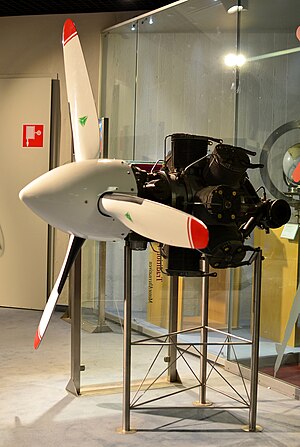| This article may rely excessively on sources too closely associated with the subject, potentially preventing the article from being verifiable and neutral. Please help improve it by replacing them with more appropriate citations to reliable, independent, third-party sources. (November 2023) (Learn how and when to remove this message) |
| Zoche ZO series | |
|---|---|

| |
| Type | "Cross-8" radial aero-engine |
| National origin | Germany |
| Manufacturer | Zoche |
The Zoche aero-diesels are a trio of radical German prototype diesel radial aero-engines intended for light aircraft, designed by Michael and Georg Zoche in the 1990s. Zoche aero-diesels are modular piston engines and are all direct-drive, air-cooled, radial two-stroke diesels with up to four cylinders per row. They all feature direct fuel-injection, two-stage charging (turbocharger and supercharger), and intercooling. In each plane (or row), all the pistons connect to a single throw on the crankshaft.
The testing and gestation period of the Zoche engines has already lasted over 25 years; and whether or when production may eventually start is unknown. However, in 2019, Georg Zoche posted this message online: "Don't worry and remain patient; we are working on it".
Design and development
The range comprises three radial engines, namely: a "cross-4"; a twin-row "cross-8"; and a V-twin. As yet, there are no plans for a 3-cylinder version.
The AOPA website explains the "cross-4" ZO 01A as follows: "The radial design was chosen for its ability to be effectively air-cooled and 100% balanced at all rpm with a simple counterweight system. All four connecting rods are attached to a single crankshaft throw. This prevents any crankshaft twisting, which is hard to balance out in opposed-configuration engines. Zoche engines use a pneumatic starting system that does away with the need for a heavy-duty starter and battery system". Propeller rotation is clockwise (viewed from the cockpit). Engine mountings are attached to the cylinder heads. Engines are to be certified to JAR-E and FAR 33, and a TBO of 2,000 hours is anticipated.
The founder of the project is Michael Zoche, who claims that the ZO engines will have the following advantages:
- they will be lightweight, compact (with low frontal area) and very smooth;
- low fuel consumption; high power-to-weight ratio;
- the lubrication system will allow aerobatics;
- diesel fuel injection, so no carburetor icing;
- direct-driven generator, so no drive belts;
- good reliability through a low part count and absence of poppet valves;
- pneumatic starting obviates both electric starter motor and heavy starter battery;
- complete absence of rubber hoses; cheaper parts through modularity;
- reduced fire risk compared to avgas;
- good power output, even at altitudes up to 9,000 feet (3,000 m).
- the engines will also have a "classic radial" appearance that is appropriate for some aircraft types.
A Zoche engine has run effectively in wind tunnel tests, but Zoche seem barely any closer to production than they were a in 2010. Experimental engine manufacturers seem to experience difficulties in proceeding beyond the prototype stage. The cited engine weights include: starter-generator, hydraulic propeller-governor, turbocharger and supercharger, and oil- and fuel-filters.
Zoche engine variants
- ZO 01A
- Single-row cross-4, 2,660 cc (162 cu in), (max) 150 hp (112 kW) @ 2500 rpm, 84 kg (185 lb)), fuel consumption 21 litres/h @ 75% power.
- ZO 02A
- Double-row cross-8, 5,330 cc (325 cu in), (max) 300 hp (224 kW) @ 2500 rpm, 123 kg (271 lb)), fuel consumption 42 litres/h @ 75% power.
- ZO 03A
- V-twin, 1,330 cc (81 cu in), (max) 70 hp (52 kW) @ 2500 rpm, 55 kg (121 lb)), fuel consumption 10 litres/h @ 75% power.
- ZO 04A
- A 2,000 hp (1,500 kW) compound diesel engine for use in the Sentinel 5000 airship on vectoring mounts.
A consequence of the modular design, with all engines sharing parts (such as an intercooler), is that the larger engines have a much higher power to weight ratio than the smaller engines, as follows:
- The 8 cylinder ZO 01A claims 2.43 bhp per kilogram;
- The 4 cylinder ZO 02A claims 1.78 bhp per kilogram;
- The 2 cylinder ZO 03A claims 1.27 bhp per kilogram.
Lambert Mission
The Lambert Mission 212, a kit-built 4-seat aircraft from Belgium, was initially designed around the Zoche ZO1A engine; but, with the non-appearance of the Zoche, Lambert were obliged to select other engines, the DeltaHawk® DH200A4 (or DH180A4), or the XP-360 engine. In May 2010 the second M212 Mission (and first kit-built example) was successfully flown.
See also
Comparable engines
- Thielert Centurion
- Wilksch Airmotive — WAM 100 (100 hp), WAM 120 (120 hp) and WAM 160 (160 hp)
- Diesel Air — 100 hp (75 kW) twin-cylinder two-stroke opposed-piston engine
- Continental O-300
- Continental O-360
- ULPower UL260i
- MidWest AE series
Related lists
References
- "Home". zoche.de.
- "Zoche aero-diesel running on wind tunnel test bench" – via www.youtube.com.
- ^ ZOCHE aero-diesel brochure
- "Horsepower of a Different Color". Archived from the original on January 8, 2007. Retrieved July 31, 2012.
- Brochure claim: "High inflight reliability – no carburetor-icing, no magneto or spark- plug problems, no vapor lock. Turbine inlet temperature is so low that it needs no monitoring. Even cylinder head temperatures are not critical.
- "zoche aero-diesels testbench video". www.zoche.de.
- Gunston, Bill (2006). World encyclopedia of aero engines : from the pioneers to the present day (5th ed.). Stroud: Sutton. p. 254. ISBN 9780750944793.
- ^ "Lambert Aircraft".
External links
- www.zoche.de — Zoche site
Patents:
- Application filed by Michael 8000 Muenchen De Zoche DE 4020826
- Diesel engine EP 0231223
- Turbocharged diesel engine US 4781028
- Radial internal combustion engine US 5197416
- Japan 63-500818